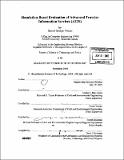Simulation-based evaluation of Advanced Traveler Information Services (ATIS)
Author(s)
Florian, Daniel George
DownloadFull printable version (6.029Mb)
Alternative title
Simulation-based evaluation of ATIS
Other Contributors
Massachusetts Institute of Technology. Technology and Policy Program.
Advisor
Moshe E. Ben-Akiva and Tomer Toledo.
Terms of use
Metadata
Show full item recordAbstract
Drivers using information from an Advanced Traveler Information System (ATIS) could potentially make better travel decisions to reduce travel time and increase trip reliability, thereby benefiting both guided drivers as well as those without such access. However, market penetration of ATIS can have dramatic effects on the performance of the transportation system in terms of overall benefits conferred as well as the distributional effects between guided and unguided drivers. Because market penetration will be determined both by private market structure and public policies, the effective deployment of ATIS depends critically on the private and public organizations that will provide these services. An understanding of the relationship between transportation system performance and ATIS market penetration provides important insights into a sustaining market structure for the ATIS industry. This thesis provides an empirical study of the impact of ATIS on transportation network quality of service using an application of DynaMIT (Dynamic network assignment for the Management of Information to Travelers). An analysis of the simulation results serves to inform the public and private stakeholder positions in the creation of a better market for ATIS. The main results are that the provision of dynamic route guidance can simultaneously benefit the individual performance of drivers, both guided and unguided, as well as the system performance of existing transportation infrastructure. In order to perform this analysis, it was necessary to develop a new software framework for the real- time integration of DynaMIT and a Traffic Management Center (TMC).
Description
Thesis (S.M.)--Massachusetts Institute of Technology, Engineering Systems Division, Technology and Policy Program, 2004. Includes bibliographical references (p. 113-115).
Date issued
2004Department
Massachusetts Institute of Technology. Engineering Systems Division; Technology and Policy ProgramPublisher
Massachusetts Institute of Technology
Keywords
Technology and Policy Program.